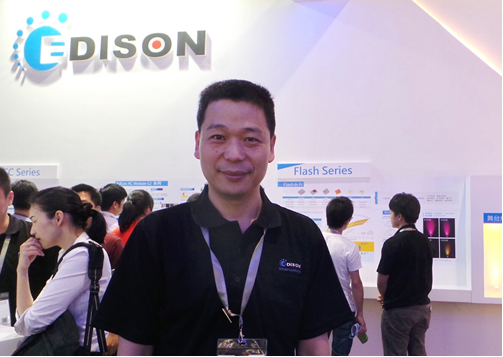The LED lighting market has gradually slowed down in recent years after a period of exponential growth, and the Chinese market is seeing intense pricing competition. These factors have driven manufacturers to advance their LED technologies and aggressively develop uncontested markets. With its focus on high-power LED components, Edison Opto establishes a leading market position by utilizing its advantages in technology expertise and R&D.
In an exclusive interview with LEDinside, Ken Chen, director of Edison Opto’s R&D division, noted that the growth rates in the lighting industry have eased and LED prices continued to decline. The company’s response to the situation has been expanding lighting applications, such as providing new products for niche markets. At this year’s International Lighting Exhibition in Guangzhou, Edison Opto displayed a diversified product portfolio for high-end applications, including AC chip-on-board (COB), chip-scale package (CSP), and flash LED products.
 |
|
Ken Chen, Director, R&D Division, Edison Opto. (LEDinside) |
Edison Opto capitalizes on integrated luminaire trend with its AC COB modules
The prices of LED products have been steadily falling due to their rising penetration in the lighting market, and encourage many traditional luminaire and lamp housing companies to embrace LEDs and moving towards the integrated luminaire design. Edison Opto, which is also proficient in luminaire design, has found new business opportunities by working with these traditional luminaire manufacturers as they lack in house LED chip and packaging capacity.
Optimistic about growth in this emerging market, Edison Opto is entering with the release of AC COB modules. The product design of the traditional chip-on-board modules, which are powered by direct current (DC), consists of LED light sources, optical lenses and a separate LED driver. In contrast, AC COB modules are modules combined with an alternating current (AC) LED driver. This integrated design is the product’s greatest advantage since clients do not have to connect an additional driver. Chen said the primary market of AC COB modules is luminaire manufacturers and they have been actively developing the new market.
To meet different regional market requirements, Edison Opto has designed two voltage models for AC COB modules: the AC 120V and AC 230V. The AC COB module is also very energy efficient and uses only 7W to deliver the same performance as traditional 40W halogen lamp. Excellent and uniform light distribution is another major benefit. Compared with DC COB modules, AC COB modules cost at least 30% less while offering simpler design. AC COB modules hence have an absolute superiority in all important competition areas.
LED packaging takes another step with the arrival of the CSP technology
Package-free products have made a splash in the LED industry since 2013, and many major manufacturers have been investing in the development of package-free chip (PFC) and chip-scale package (CSP) products. CSP in particular emerges as a valuable technology that reduces LED package size, improves thermal dissipation and increases chip reliability.
CSP has eliminated the usage of LED lead frames which allows direct phosphor coating on the LED chip and creates a much wider beam angle. The CSP technology raises LED package density and production efficiency as well as making integrated design easier. Moreover, CSP allows more even light distribution and the beam angle can be further widened with additional lenses. In addition to the lighting applications, Edison Opto plans to introduce the CSP technology to a wide range of applications, such as backlight, camera LED flash for smartphones and automotive LED lighting
 |
|
A comparison between PLCC and CSP LED beam angles. (Photo courtesy of Edison Opto) |
In backlight applications, for instance, CSP can greatly reduce LED usage volume because of its wider beam angle and ability to be driven at higher voltages. Korean LED manufacturers have widely adopted CSP in backlight light applications since 2014.
Edison Opto believes the smartphone market has huge potentials and is committed to the R&D and production of LEDs for camera flashes. The company’s recent camera flash products combine vertical chip technology with CSP, which is suitable for high voltage applications. Edison Opto is also using the CSP technology to build better LED car headlights. Many cars now feature smart LED headlights with technologies that seek smaller light sources in order to create more focused headlight beams. The compactness of CSP-based LED packages therefore allows more flexible headlight design.
Edison Opto has the technological leverage to overcome the chaotic price wars
The LED lighting market’s rapid growth in the recent years has made price wars inevitable. According to Chen, Edison Opto’s main strategy in this uncertain market environment has been brand differentiation. As the growth of the lighting industry slows down, Edison Opto intends to branch out into many applications. AC COB, CSP, automotive LED lighting products and camera flash LED products are examples of this company’s aggressive efforts in developing niche markets.
In addition, Edison Opto is more optimistic about the outdoor lighting market relative to the indoor lighting market, as the latter is moving towards saturation. The company’s economical AC modules (including the COB type) will become an important market trend in the near future.
Edison Opto has utilized its strengths in R&D and technology to deploy its strategy for different market applications. The company has carved out its own path within the current lighting market that features tumultuous price wars. Efforts in asserting brand characteristics and using technical expertise to create value-added products will continue to build up Edison Opto’s unique position.
 |
|
Edison Opto booth at GILE 2015 (Photo courtesy of Edison Opto) |
(Author: Carina Ying, Editor, LEDinside http:// Translator: Judy Lin, Chief Editor, LEDinside)





 CN
TW
EN
CN
TW
EN








